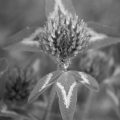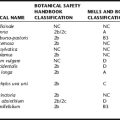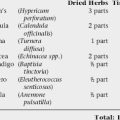BlUE COHOSH
Botanical name: Caulophyllum thalictroides
Synonyms: Papoose root, squaw root
MAJOR CHEMICAL CONSTITUENTS
The major chemical constituents are quinolizidine alkaloids including thalictroidine, N-methlycytisine, anagyrine, magnoflorine sparteine, baptifoline, and caulophyllumine, and the saponins caulosaponin and caulophyllosaponin.1–4
PRINCIPAL USES
TRADITIONAL AND HISTORICAL USES
Caulophyllum thalictroides (blue cohosh), a native of the eastern and central woodlands of the United States, is reported to have been used traditionally and historically as an anticonvulsant, antirheumatic, febrifuge, emetic, sedative, and most notably, a gynecologic aid.5,6 Interestingly, in modern clinical practice, blue cohosh is used almost exclusively for gynecologic and obstetric purposes. It is not commonly used for anticonvulsant, sedative, or antirheumatic actions, whereas the unrelated herb Actaea racemosa syn. Cimicifuga racemosa is used for these purposes, as well as a uterine antispasmodic for the treatment of painful gynecologic conditions such as dysmenorrhea. It is this author’s suspicion that some of the uses of black cohosh have been overlaid on blue cohosh in the historical literature because of the similar common name, confounding an interpretation of the traditional uses of blue cohosh.
Blue cohosh has been used for labor induction, amenorrhea, dysmenorrhea, menorrhagia, and the induction of abortion.5 Blue cohosh was official in the United States Pharmacopoeia from 1882 to 1905 for labor induction, and in the National Formulary from 1916 to 1950. It was a major ingredient in the popular Eclectic preparation Mother’s Cordial, which also included Mitchella repens, Rubus idaeus, Cimicifuga racemosa, and Chamaelirium luteum. At least one company (Herbalist and Alchemist, NJ) still makes this preparation; however, the blue cohosh has been removed as an ingredient in the product because of safety concerns. The practice of labor induction with blue cohosh remains a popular choice both among self-prescribers and obstetric professionals in the United States and abroad, with large surveys indicating widespread use among nurse-midwives.7
IN VITRO, ANIMAL, AND CLINICAL DATA
Uterine stimulant properties were observed using blue cohosh extract on isolated guinea pig tissue; however, subsequent in vivo studies with cats, dogs, and rabbits failed to demonstrate uterine activity. Smooth muscle stimulation has been seen in vitro on small intestine and in vivo on coronary blood vessels of small animals using caulosaponin. Caulosaponin has also demonstrated an oxytocic effect on tissue from rat uteri, in vitro constriction of carotid vessels, myocardial toxicity, and intestinal spasmogenicity on isolated intestinal tissue. Methylcystine has a nicotinic-like action resulting in blood pressure increases, respiratory stimulation, and increased intestinal motility. Clinical studies using blue cohosh are absent.
RATINGS
USE IN PREGNANCY AND LACTATION
Use of blue cohosh during pregnancy to “prepare” the uterus for parturition is a widespread practice among midwives and pregnant women.7 Although this practice is rarely associated with significant adverse outcomes, maternal ingestion has been associated with a range of fetal and neonatal side effects, including fetal tachycardia and increased meconium, as well as several case reports of profound neonatal congestive heart failure and perinatal stroke.7,9–12 There is one case report of a neonate born with complications including myocardial infarction and profound congestive heart failure to a mother who ingested blue cohosh capsules as a partus preparator. The newborn remained critically ill for several months, and at 2 years old required continued digoxin therapy for poor ventricular function. All other causes of myocardial infarction were excluded.11,13 In another case report a child was born with severe multiorgan failure associated with the use of a blue and black cohosh combination. The child required significant resuscitation at birth and sustained permanent CNS damage.12 Neither the amount nor duration used were disclosed. It should be noted that midwives attempted to resuscitate this newborn at home for 30 minutes prior to contacting emergency services. The effects in both cases have been attributed to vasoactive glycosides in the herb. A 21-year-old woman developed symptoms of nicotinic toxicity, including tachycardia, diaphoresis, abdominal pain, vomiting and muscle weakness, and fasciculations after using blue cohosh in an attempt to induce an abortion. These symptoms likely resulted from methylcysteine, which is known to be present in blue cohosh. The patient’s symptoms resolved after 24 hours and she was discharged.14
Alkaloid and glycoside components in blue cohosh suggest possible mechanisms for these effects, as well as teratogenicity and mutagenicity, however, the case reports involving neonatal adverse events are inconclusive.1,14 N-methylcytisine exhibited teratogenic activity in the rat embryo culture (REC), an in vitro method to detect potential teratogens. Taspine showed high embryotoxicity, but no teratogenic activity, in the REC.15 Toxic effects of the plant’s constituents include coronary vasoconstriction, tachycardia, hypotension, and respiratory distress; however, one author cautions that the quality of the case reports to date, and the value of some of the testing methods used to establish toxicity may be questionable. For example, although REC tests have shown teratogenicity and embryotoxicity, “neither the National Institute of Environmental Health Sciences nor the Environmental Protection Agency recognizes these tests as an appropriate screen for human reproductive risk.”16 Similarly it has been speculated that anagyrine, which produces known malformations in ruminant livestock, may do so only after metabolism by microflora in the ruminant gut.
The Botanical Safety Handbook classifies this herb as 2b, not to be used during pregnancy; however, it states that Caulophyllum may be used as a parturient near term to induce childbirth under the supervision of a qualified practitioner.17 Canadian regulations require that any products containing this herb be labeled as not for use in pregnancy. Given the volume of blue cohosh use in the United States alone, and the general paucity of reports of its side effects, as well as a lack of comparison of side effects with conventional medications for labor augmentation (i.e., pitocin, misoprostel), it remains uncertain how great a risk is posed by the use of blue cohosh, particularly for short-term labor augmentation as opposed to long-term use as a partus preparator. Nonetheless, physician–herbalist Tieraona Low Dog states, “The human case reports, flawed as they are, paint a picture that is consistent with the evidence provided by the in vitro and animal studies.”16
The most conservative route is to avoid its use entirely as a partus preparator, and possibly at all during pregnancy, until further safety information is established. Midwives and mothers choosing to use blue cohosh to augment labor should consider continuous fetal heart evaluation during use and discontinue use promptly if abnormal patterns are observed. No discussion on the safety of blue cohosh during lactation is reported in the literature. One case report in the literature describes an infant born with skeletal dysplasia and vascular anomalies to a mother who had consumed anagyrine containing goat milk; however, as stated, it is not known whether activation of this compound requires metabolism in the ruminant gut.18
Blue cohosh should never be used during the first or second trimesters of pregnancy. The most conservative—and safest—route is to avoid the use of blue cohosh as a partus preparator, and possibly at all during pregnancy, until further safety information is established. The safety of its use to augment labor has not been established; any such use should be accompanied by the supervision of a health professional skilled in midwifery or obstetric and herbal care.
SAFETY INFORMATION: HERB DRUG INTERACTIONS, TOXICITY, AND CONTRAINDICATIONS
Because of its potential vasoconstrictive activities, its use is cautioned in patients with hypertension, cardiovascular disease, and those on hypertensive medications. There have been no documented reports of drug interactions with blue cohosh,19 although blue cohosh powder may be irritating to the mucus membranes. Caulosaponin may be cardiotoxic, causing constriction of the coronary vessels, and methylcysteine could theoretically increase blood pressure in excessive doses; however, this has not been documented.
1. Kennylly E, Flynn T, Mazzola E, et al.: Detecting potential teratogenic alkaloids from blue cohosh rhizomes using and in vitro rat embryo culture.
2. Betz J, Andrzejewski D, Troy A, et al. Gas chromatographic determination of toxic quinolizidine alkaloids in blue cohosh Caulophyllum thalictroides (L.) Michx. Phytochem Anal. 1998;9:232-236.
3. Ganzera M, Dharmaratne H, Nanayakkara N, Khan I. Determination of saponins and alkaloids in Caulophyllum thalictroides (blue cohosh) by high-performance liquid chromatography and evaporative light scattering detection. Phytochem Anal. 2003;14(1):1-7.
4. Jhoo J, Sang S, He K. Characterization of the triterpene saponins of the roots and rhizomes of blue cohosh (Caulophyllum thalictroides). J Agric Food Chem. 2001;49(1):5969-5974.
5. Moerman D. Native American Ethnobotany, 3 ed. Portland, OR: Timber Press, 2000.
6. Felter H, Lloyd J. King’s American Dispensatory. Cincinnati: reprinted by Eclectic Medical Publications, 1983. 1898
7. McFarlin B, Gibson M, O’Rear J, Harman P. A national survey of herbal preparation use by nurse-midwives for labor stimulation. Review of the literature and recommendations for practice. J Nurse Midwifery. 1999;44:205-216.
8. Mills S, Bone K. The Essential Guide to Herbal Safety. St. Louis: Churchill Livingstone, 2005.
9. McFarlin B, Gibson M, O’Rear J, Harman P. A national survey of herbal preparation use by nurse-midwives for labor stimulation: review of the literature and recommendations for practice. J Nurse Midwifery. 1999;44(3):205-216.
10. Finkel R, Zarlengo K. Blue cohosh and perinatal stroke [correspondence]. NEJM. 2004;351(3):302-303.
11. Jones T, Lawson B. Profound neonatal congestive failure caused by maternal consumption of blue cohosh herbal medication. J Pediatr. 1998;132:550-552.
12. Wright I. Neonatal effects of maternal consumption of blue cohosh. J Pediatr. 1999;134(3):384-385.
13. Jones T, Lawson B. Profound neonatal congestive heart failure caused by maternal consumption of blue cohosh herbal medication. J Pediatr. 132(3), 2003. (Part 1)
14. Rao R, Hoffman R. Nicotinic toxicity from tincture of blue cohosh (Caulophyllum thalictroides) used as an abortifacient. Vet Hum Toxicol. 2002;44(4):221-222.
15. Kennelly E, Flynn T, Mazzola E, et al. Detecting potential teratogenic alkaloids from blue cohosh rhizomes using an in vitro rat embryo culture. J Nat Prod. 1999;62(10):1385-1389.
16. Low Dog T. Women’s Health in Complementary and Integrative Medicine: A Clinical Guide. St. Louis: Mosby, 2004.
17. McGuffin M, Hobbs C, Upton R, Goldberg A. Botanical Safety Handbook, 231, 1997, CRC Press, Boca Raton, FL
18. Oretega J, Lazerson J. Anagyrine-induced red cell aplasia, vascular anomaly, and skeletal dysplasia. J Pedatr. 1987;111:87-89.
19. Barnes J, Anderson L, Phillipson J. Herbal Medicines, 3 ed. London: Pharmaceutical Press, 2007.








